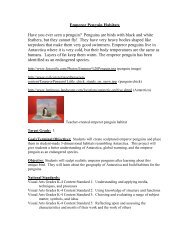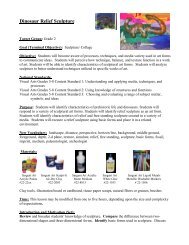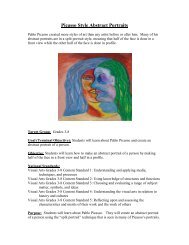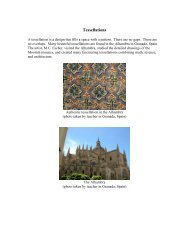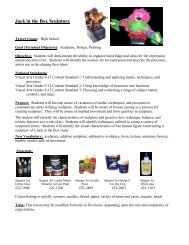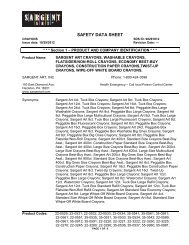Clown/Circus Animal Shape Portraits - Sargent Art
Clown/Circus Animal Shape Portraits - Sargent Art
Clown/Circus Animal Shape Portraits - Sargent Art
You also want an ePaper? Increase the reach of your titles
YUMPU automatically turns print PDFs into web optimized ePapers that Google loves.
<strong>Clown</strong>/<strong>Circus</strong> <strong>Animal</strong> <strong>Shape</strong> <strong>Portraits</strong>Target Group: KindergartenGoal (Terminal Objective): Students will learn the elements of art (Lines, Colors, and<strong>Shape</strong>s) and apply creative problem solving to complete an original clown or circusanimal portrait based on the artwork of the author and artist Lois Elhert. Students willalso learn to how to combine shapes to achieve new ones.Objective: Students will demonstrate their visual understanding of the elements of art bycreating a clown or circus animal portrait, which also exhibits their knowledge of basiclines, shapes, and colors upon completion of the artwork.National Standards:Visual <strong>Art</strong>s Grades K-4 Content Standard 1: Understanding and applying mediatechniques, and processesVisual <strong>Art</strong>s Grades K-4 Content Standard 3: Choosing and evaluating a range of subjectmatter, symbols, and ideasVisual <strong>Art</strong>s Grades K-4 Content Standard 5: Reflecting upon and assessing thecharacteristics and merits of their work and the work of othersPurpose: Students will look at examples of works of art by author/ artist Lois Elhert forinspiration (Literature Integration). Students will apply their knowledge and create anoriginal clown drawing using repeated shapes, lines, and colors. Students will visuallydemonstrate knowledge of elements of art in their original choices of shapes, lines, and
colors to complete the composition. Students will identify and use different types ofshapes and lines (Math Integration).New Vocabulary: trace, circus, clown, combine, circle, star, triangle, oval, rectangle,pattern, lines, portraitMaterials:Pink or yellow construction paper (example is 9”x 12”), pre-cut /laminated shapes (circle,oval, rectangle, star, and triangle,) <strong>Sargent</strong> <strong>Art</strong> Crayons (#22-0534) 24 count, <strong>Sargent</strong> <strong>Art</strong>Markers Broad Tip 8 count (#22-1530), <strong>Sargent</strong> <strong>Art</strong> Jumbo Crayons (#22-0531), andpencils.Crayons Jumbo Crayons 8-count Broad and Fine TipMarkers#22-0534 #22-0531 #22-1530Time: approximately 1-2 class periodsInstruction and Motivation (Set):A. Teacher will read the story book “<strong>Circus</strong>” by Lois Elhert. Have students namethe basic lines and shapes (straight, curved, zigzag, dotted, rectangle, circle,triangle, etc.) and find them in Elhert’s book/artwork. Students will be guided todiscover the colors, lines, and shapes in Elhert’s artwork/book.B. Teacher will show examples of student-completed clown or circus animalportraits.C. The teacher will demonstrate how to trace pre-cut shapes in pencil and markerto create a figure or animal. Teacher will discuss pattern and have childrenidentify patterns on their clothing.Resources: <strong>Art</strong>ist Exemplar book <strong>Circus</strong>” by Lois Elhert or the book Color Zoo.
Student Examples Grade KindergartenInstruction:1) Students may select a pink or yellow piece of construction paper. Begin by havingstudents label the back of their paper with their name using a pencil.2) Using a pencil, students will trace and arrange pre cut laminated shapes to create ananimal or clown. <strong>Shape</strong>s may be combined or placed next to or on top of one another.Students will be encouraged to add a background and or pattern to their picture.
3) Students will then use a black sharpie marker or black marker to trace the pencilshapes.4) Next, students will color in the outlined marker shapes with assorted crayons. Theyshould color them in solidly.
Activities:(1) Guided Practice:a. Students view and discuss examples of artwork representing circus themes thatutilize basic shapes.b. Students discuss the art elements that include types of lines, shapes, and colors.c. Students demonstrate their technical ability to trace pencil lines and colorevenly, and to fill the space to achieve an original clown or animal portrait.(2) Independent Practice and Check for Understanding:a. Teacher will circulate and help students with design questions. Teacher maymake suggestions to students to combine shapes or to add art elements.b. Teacher may offer individual help with tracing or coloring smoothly and evenlyand effective use of shapes.(3) Closure: Teacher leads students in a discussion of what art elements (shapes, colors,lines) each student used or colors mixed to create their clown or circus animal. Teacherwill inquire why students chose those shapes and ask students to locate where there is apattern.Evaluation:Level One -- The finished design very successfully demonstrates the student’sunderstanding of the elements of art. The student has shown strong technical skills intheir use of drawing and use of shapes or colors. The student has shown a high level ofcreativity in completing the motif with original detail. Craftsmanship is outstanding.Level Two -- The finished design demonstrates the student’s understanding of theelements of art. The student has shown good technical skills in his/her use of drawing and
use of shapes or color. The student has shown creativity in completing the motif withoriginal detail. Craftsmanship is good.Level Three -- The finished design demonstrates effort on the student’s part to showhis/her understanding of the elements of art. The student has shown little technical skill inhis/her use of drawing or use of shapes or color. The student has shown limited creativityin completing the motif with any detail. Craftsmanship is minimal.Level Four -- The finished design lacks evidence of the student’s understanding ofelements of art. There is no technical skill shown in his/her use of shapes or use of color.The student’s final project lacks creativity and craftsmanship.Extension: This project can be greatly simplified for younger students, or vice versa forolder, more advanced students. Oil pastels or watercolor crayons could be used for adifferent visual effect. In addition, students could be asked to use just one shaperepeatedly in different sizes.Resources:http://www.rif.org/art/illustrators/ehlert.mspx biography and information on author LoisElhert<strong>Circus</strong> book- by Lois Elhert, Color Zoo by Lois ElhertBY RISELLE ABRAMS<strong>Art</strong> Consultant_____________________________________________________________________________www.sargentart.com 01/27/2008



